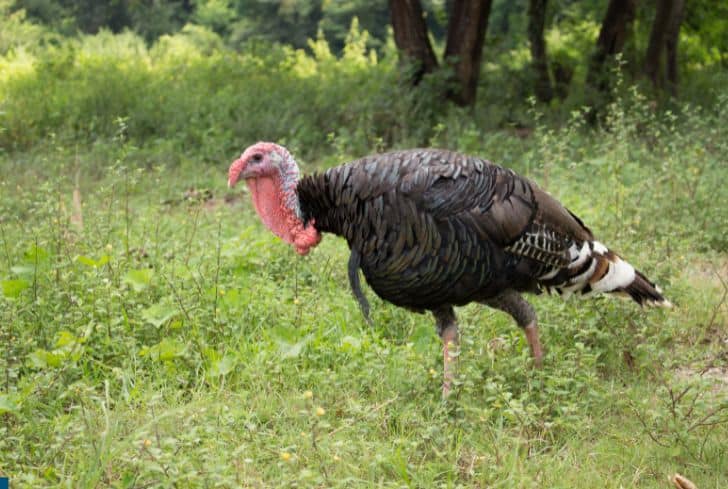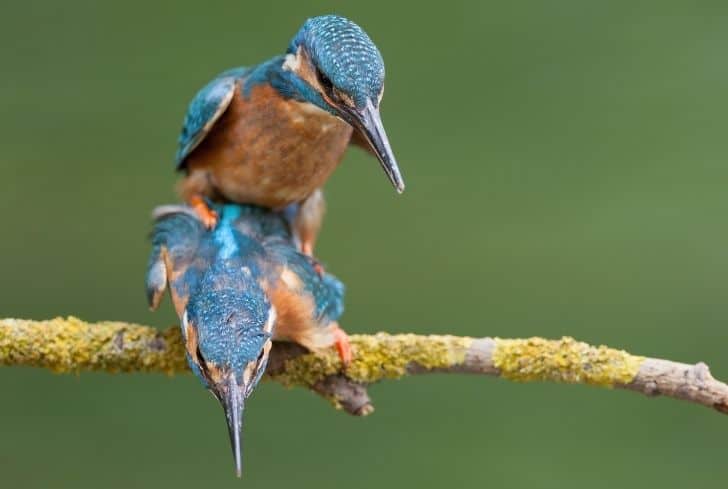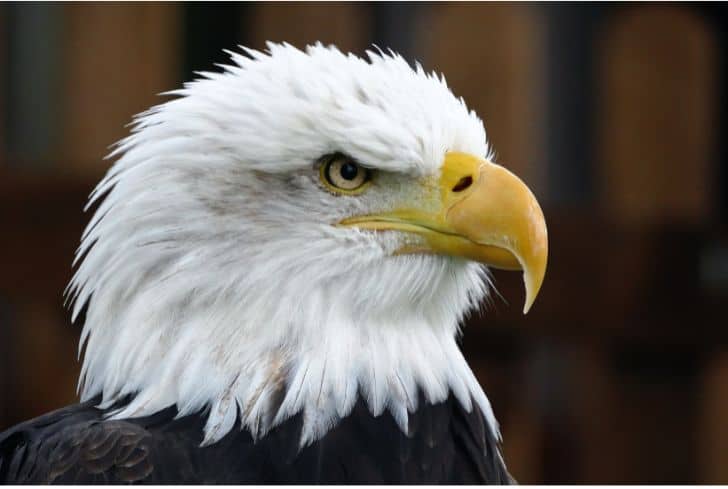How High, Fast and Far Can Turkeys Fly? (Answered)

Turkeys are large birds native to North America. They have been domesticated from as early as 800 BC and have become the main delicacy for special occasions like Christmas and Thanksgiving in America.
But have you ever wondered if these plump birds can fly? In this article, we are going to look at the flying abilities of the wild turkey and its domesticated counterpart. We will go into detail about its physical anatomy, its speed, and the height that it can attain. We will also discuss the roosting habits of the turkey.
How High Can a Turkey Fly?
Wild turkeys do have some limited flying ability. They can propel themselves into the air in short, powerful bursts. This helps them to escape predators and to reach branches for roosting overnight, away from dangers. They can usually fly high enough to reach branches at a height of 6 to 9 meters.
They aim to usually fly just high enough to reach the primary branches of broad-leaved trees. Sometimes, they can go as high as 15 m (50 feet) off the ground to reach the right branch. A thick, horizontal branch on the lower part of the trunk is the perfect roosting spot, and turkeys tend to revisit one particular spot.
It’s important to note that only wild turkeys have this limited ability to fly. Domestic turkeys cannot fly at all because they are specifically bred and reared for their meat, which makes it impossible for them to fly.
How Fast Does a Wild Turkey Fly?
Wild turkeys fly in short, powerful bursts, and they can reach up to 55 mph (90 km/h) in the air. However, they cannot stay in the air for a long time or cover a large distance. The ability to fly in powerful bursts allows them to escape their predators or reach a safe roosting spot.
Turkeys are much better at running than flying. They can run at up to 25 mph (40 km/h) over long distances. Turkeys spend 99.9% of their lives on their legs, so they are somewhat built like a hoofed animal, says Ken Dial, professor at the University of Montana.
The bodies of turkeys seem pressed laterally, with their knees pulled in and their legs spread. The legs possess great circulation which allows for sustained running. The powerful legs also help the turkeys to fly.
When they are about to take off, the turkeys squat slightly and then explode upwards from the legs to fly. This is in contrast to birds like the albatross, which need to run a short distance (like a plane) to take off.
How High Can Wild Turkeys Fly?
Wild turkeys can fly as high as 15 m (50 feet). However, they only perform explosive, short-distance flights, and they cannot sustain flying over long distances or time. But still, their limited flying ability is enough to help them escape from predators or to reach a tree branch for roosting.
By appearance, it seems impossible that turkeys can ever fly. Their bodies look too big for their skinny legs, and they have strange physical features, such as the dewlap (flap of skin under the chin) and the snood (fleshy bumps on the forehead). Yet, turkeys can indeed fly in short bursts.
The flying of turkeys may not look as graceful as that of the eagle or as quick as that of the hummingbird, but it still serves two important purposes—escaping predators and reaching roosting spots—for the turkey.
How Far Can the Average Turkey Fly?
On average, a wild turkey can fly for about 100 yards. It’s not a large distance, but it’s enough for the turkey to escape the predator or reach a branch for roosting. Its body—including the breast muscles and wings—is specially designed for these explosive, short-burst flights.
A turkey’s breast muscles are not developed to support flights over long distances. They are built for quick but brief bursts of flight. Glycogen is the energy-giving chemical which flows into the turkey’s breast to support flight, and it is used up very quickly. Ken Dial says it’s like the nitro fuel for a drag racer.
The turkey’s wings are also designed to support their short bursts of flying. Their wings are cupped, something that is known as camber in aerodynamics—an asymmetry between the two acting surfaces of an airfoil.
Wild turkeys are much better at running on the ground than flying, and they spend most of their lives finding food on land. Flying is reserved for times when they need to escape a predator or when they need to reach a branch to rest.
Why Can’t Domestic Turkeys Fly?
Turkeys have been domesticated for more than 2000 years, and over time, they have lost their ability to fly. The domestic turkey is bred and reared specially for its meat, and because of its large size, they are unable to fly. Moreover, since they do not face the threat of predators, they don’t need to fly.
Since domestic turkeys are bred for their meat, their breasts are larger, and they are much heavier than wild turkeys. They are a lot less agile and cannot fly. The large breast muscles also stretch the tendons and ligaments, pushing the shoulder joints further apart. This further inhibits flight. Wild turkeys, on the other hand, have strong and stable shoulder joints, which allow flying.
Experts also suggest that an element of psychology is also involved. Domestic turkeys are supposed to use all calories to build muscle, instead of wasting them on flights. So in some ways, farmers have bred turkeys to refrain from flying.
Moreover, the living conditions of domestic turkeys also discourage flying. They are often kept in tiny indoor spaces where they can’t spread their wings. Natural predators are nowhere around, so turkeys also don’t need to attempt flying to escape them.
The domestic turkey we cook on holidays does not have dark meat precisely because these birds do not fly. Dark meat is muscle meat that has been fed by blood. In the case of wild turkeys, which use their breast muscles to fly, the colour is dark. But in domestic turkeys, it is generally white.
In most cases, domestic turkeys are so heavy that they cannot even copulate naturally. They have to be artificially inseminated.

Can Turkeys Fly Into Trees?
Yes, turkeys can fly high enough to reach tree branches. They usually pick branches that are about 6-9 m in height but can go as high as 15 m. Turkeys cannot fly over long distances but they can make flights in short bursts. They usually do this for two reasons: to escape predators and to fly into trees.
Turkeys usually pick a tree which is near to both water and food sources. They also prefer trees in the open country instead of those in dense forests; this gives them the option to fly and run easily if any danger comes.
Can all Turkeys Fly?
No, only wild turkeys can fly, and that too, only in short bursts. This allows them to escape predators and reach trees for roosting. On the other hand, domestic turkeys are bred only for their meat, and their heavy build makes them a lot less agile. Forget flying, they cannot even perform natural acts like copulation.
Domestic turkeys cannot fly because they are bred to have larger breast muscles, which inhibits their flying ability. Because of their living conditions, they often do not have the space to fly. Finally, they don’t need to fly at all, since they are kept safe in enclosures, away from predators.
Do Turkeys Migrate?
No, turkeys do not migrate. They cannot undertake the long flights required for migration. They can only fly in short bursts to escape predators or reach trees for roosting. Since they cannot migrate, they have found other ways to adapt to the changing conditions of the environment.
For example, when the temperature drops, wild turkeys use their body fat to keep themselves warm. They can survive at temperatures as low as 40°F (or 4°C). They can also survive for two weeks without food.
When the weather is too harsh, they roost high up on a tree in hibernation mode for a long time and come down only when it’s safe.
Do Wild Turkeys Sleep in Trees?
Yes, wild turkeys sleep in trees at night to avoid predators. The ability to make short bursts of flights allows them to reach branches of trees, where they can rest in peace. They usually select large trees with broad branches, such as oaks and sycamores.
They pick a strong, wide branch, and take a squatting position. Their feet grip the branch tightly, allowing them to balance their weight without any risk of falling. So, while the turkeys may not be able to fly as gracefully as many other birds, their limited ability still allows them to reach trees and roost in safety.
Conclusion
In this article, we discussed the flying ability of turkeys. Domestic turkeys are bred mainly for their meat, and their heavy weight does not allow them to fly. Wild turkeys, on the other hand, can fly in short, explosive bursts. This helps to escape predators and to fly up to tree branches where they can roost in safety.






